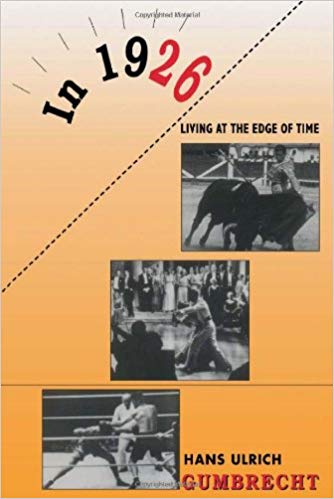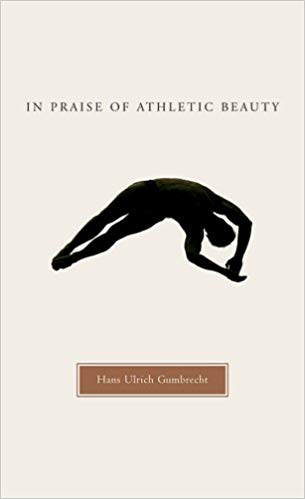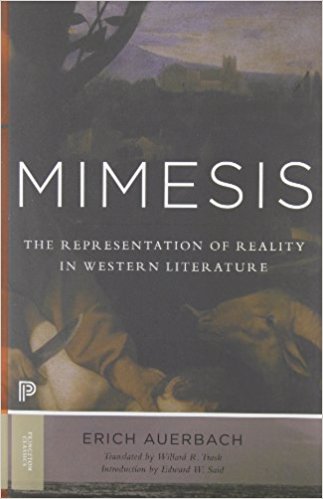
Brazil’s João Cezar de Castro Rocha: an interpreter of “Gelassenheit”
I know what you’re thinking. Back at at the “Sepp Fest” last February for Hans Ulrich Gumbrecht (a.k.a. Sepp), I promised a third installment after “Public intellectuals, private intellectuals, and a professor of football” and “’My weight is my love’: on Augustine, Calvino, and Sepp Gumbrecht”. But what did you get from me? Silence.
Until now.

Sepp: More intense ’cause he’s more serene? (Photo: Reto Klar)
Here is the third post on the celebration from two-day retirement party for Sepp, and it comes all the way from Brazil. João Cezar de Castro Rocha of the State University of Rio de Janeiro gave a talk in February on “Gelassenheit.” The term became an important analytic tool for Sepp as he studied the life of Erich Auerbach, the author of Mimesis: The Representation of Reality in Western Literature. But the term has a long history, not only in Martin Heidegger but going all the way back to Meister Eckhart. When I interviewed Sepp, he used the term to describe René Girard, and defined it as a “Let-It-Be-ness,” or as I eventually described in Evolution of Desire: A Life of René Girard, “accepting things in their uncertainty and their mystery.” But it isn’t that simple.
João notes that Sepp’s initial translation of the world was composure:
On the one hand, it signals Sepp’s initial engagement with Martin Heidegger’s philosophy. To put it more precisely: with an intense reading of Sein und Zeit; as a matter of fact and above all with Heidegger’s phenomenological descriptions of everyday life. Sepp’s 1998 book In 1926. Living on the Edge of Time is a first and robust outcome of this specific concern, which is related to lived experience as such, attributing to it, let us say, an intellectual dignity, which resembles Auerbach’s reconstruction of Western literary experience, and its serious and potentially tragic understanding of ordinary, everyday life.
 On the other hand, it should be highlighted that from the very beginning of his engagement with the concept, and even in its translation as composure, Gelassenheit never meant to Sepp acceptance, resignation, in one word: quietude. Rather, I propose the following rendering of Sepp’s translation: composure implies a particularly active relationship with current events, in which the present is projected into a much wider chain of events, and going back and forth different historical periods is the trademark of Gelassenheit understood as composure – a trademark also of Erich Auerbach’s masterpiece, Mimesis.
On the other hand, it should be highlighted that from the very beginning of his engagement with the concept, and even in its translation as composure, Gelassenheit never meant to Sepp acceptance, resignation, in one word: quietude. Rather, I propose the following rendering of Sepp’s translation: composure implies a particularly active relationship with current events, in which the present is projected into a much wider chain of events, and going back and forth different historical periods is the trademark of Gelassenheit understood as composure – a trademark also of Erich Auerbach’s masterpiece, Mimesis.
Auerbach’s Mimesis, he pointed out, is “an impressive narrative of a failure” of Western culture, and can even be read as a powerful anti-Nazi statement. “You see my point: composure has nothing to do with acceptance of a present filled with tragic happenings, but rather it entails an active withdrawal from the, let us say, tyranny of the present; withdrawal which enlightens the relativity of any given historical time.”
Then João cut to the chase: “I’ll now propose that from 1995 onwards Sepp’s understanding of Gelassenheit started to change slowly but steadily, and as time went by the change became so radical that it opened up a new path in Sepp’s work.”
Then he told a story:
In 1995 Sepp Gumbrecht, along with Jeffrey Schnapp, Ted Leland, Bill Egginton and Rich Schavone, organized what, with hindsight, can be seen as a breakthrough event, bringing together athletes and academics. I’m referring to the conference “The Athletes’s Body.”
 In the Q&A session, the three-time Olympic gold-medal swimmer Pablo Morales was asked what he missed the most of his life as a top athlete. Morales’s answer was in itself eventful. He did not exactly miss the exhaustive training routine, although the discipline required by it can be fully appreciated. Indeed, almost all top athletes have impose on their bodies such stress throughout their careers that the most common outcome is a series of injuries they have to endure their entire lives. Nor even gold medals and world records were what Morales missed the most; after all a top athlete is obsessed with improving her performance, therefore, any victory may be clouded by the seemingly inescapable question: could I have done it any better?
In the Q&A session, the three-time Olympic gold-medal swimmer Pablo Morales was asked what he missed the most of his life as a top athlete. Morales’s answer was in itself eventful. He did not exactly miss the exhaustive training routine, although the discipline required by it can be fully appreciated. Indeed, almost all top athletes have impose on their bodies such stress throughout their careers that the most common outcome is a series of injuries they have to endure their entire lives. Nor even gold medals and world records were what Morales missed the most; after all a top athlete is obsessed with improving her performance, therefore, any victory may be clouded by the seemingly inescapable question: could I have done it any better?
So what was it that Morales really missed from his athlete’s life?
Pablo Morales told us that above all he longed for the moment immediately before jumping into the swimming pool in a day of an important competition just like the Olympic Games. Then, Morales felt the world to be a blank page, an untouched canvas, where everything is possible, and the best performance ever is at hand. In his own words, in this very moment he felt “lost in focused intensity”.
Being lost in focused intensity, I propose, has triggered Sepp’s new understanding of Gelassenheit, and it is not a coincidence that at the same time Sepp was engaging ever more intensely with a highly personal reading of Heidegger’s philosophy. The process was not without hindrances, and in 2003 Sepp published Production of Presence. What Meaning Cannot Convey, providing the basis for a theoretical framework of his own, which enabled him to turn intensity, that is, his new translation of Gelassenheit into a form of thinking. Intensity as a special form of Gelassenheit has become not only Sepp’s own Gedankenexperiment but also an everyday aesthetics – as you already know, no ethics should be attached to Sepp’s works.
 After all, what is a seminar taught by Sepp if not an immersion in Gelassenheit? It is not the case with Sepp’s wrap-up of a panel – be it surprisingly good or merely mediocre? In both cases, while rendering more complex the ideas espoused by the speakers, Sepp is creating an environment where it becomes possible, almost at hand, to find themselves lost in focused intensity.
After all, what is a seminar taught by Sepp if not an immersion in Gelassenheit? It is not the case with Sepp’s wrap-up of a panel – be it surprisingly good or merely mediocre? In both cases, while rendering more complex the ideas espoused by the speakers, Sepp is creating an environment where it becomes possible, almost at hand, to find themselves lost in focused intensity.
João concluded that Sepp’s most recent work redefines Gelassenheit, and perhaps we should, too. “I suggest that we move from composure to serenity.” He continued:
However, as we did with the notion of composure, we have to enrich our understanding of serenity. It should not be seen either as calmness or as quietude. I propose we equate serenity with stillness, but only insofar as the absence of motion, implied in the meaning of stillness, resonates Pablo Morales’s experience of being lost in focused intensity. In other words, in Sepp’s work, stillness means to be in absolute concentration immediately before jumping into the swimming pool in an Olympic Game or, for that matter, immediately before delivering a thought-provoking lecture. After all, academics also perform their intellect, even if they are not aware of it.
Then, to conclude I believe that we can pinpoint two or three definitions of Gelassenheit that may enlighten Sepp’s current work.
First: Gelassenheit demands a Messianic time, in the sense put forward by Walter Benjamin, but as long as the Messiah is not expected to come, so time remains open to the openness of time.
 Second: Gelassenheit as serenity is the form of emergence, in the sense developed by Umberto Maturana and Francisco Varela, notion that along with autopoiesis were important in the unfolding of the theoretical framework of the materialities of communication paradigm.
Second: Gelassenheit as serenity is the form of emergence, in the sense developed by Umberto Maturana and Francisco Varela, notion that along with autopoiesis were important in the unfolding of the theoretical framework of the materialities of communication paradigm.
Finally, as serenity, Gelassenheit is the emergence of form; form, in the sense developed by George Spencer Brown, as the difference between in and out, interior and exterior, propitiating what could be called the aesthetics of Sepp’s thought experiments.
If the ideas I proposed here are good to think with – as the myths are for Claude Lévi-Strauss – I may now conclude by suggesting that, as time goes by, Sepp becomes ever more intense because at last he has learned to be a bit more serene.
Well, I lost whatever small measure of Gelassenheit I have when João told me the eminent house É Realizações Editora in São Paulo would be translating and publishing Evolution of Desire: A Life of René Girard in Portuguese for a Brazilian translation. Wheee! Uncork the champagne!
Tags: Bill Egginton, Erich Auerbach, Hans Ulrich Gumbrecht, Jeffrey Schnapp, João Cezar de Castro Rocha, Martin Heidegger, Pablo Morales, René Girard, Rich Schavone, Ted Leland
